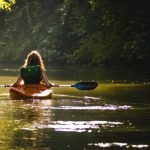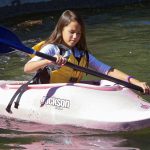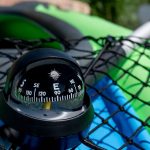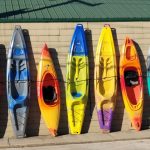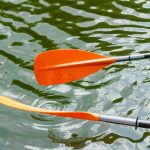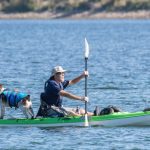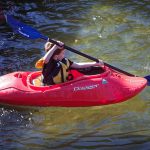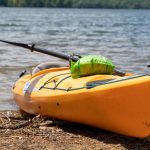Picking your first kayak paddle is a daunting task. In this article, we review some models that we consider the best kayak paddles for beginners. Enjoy!
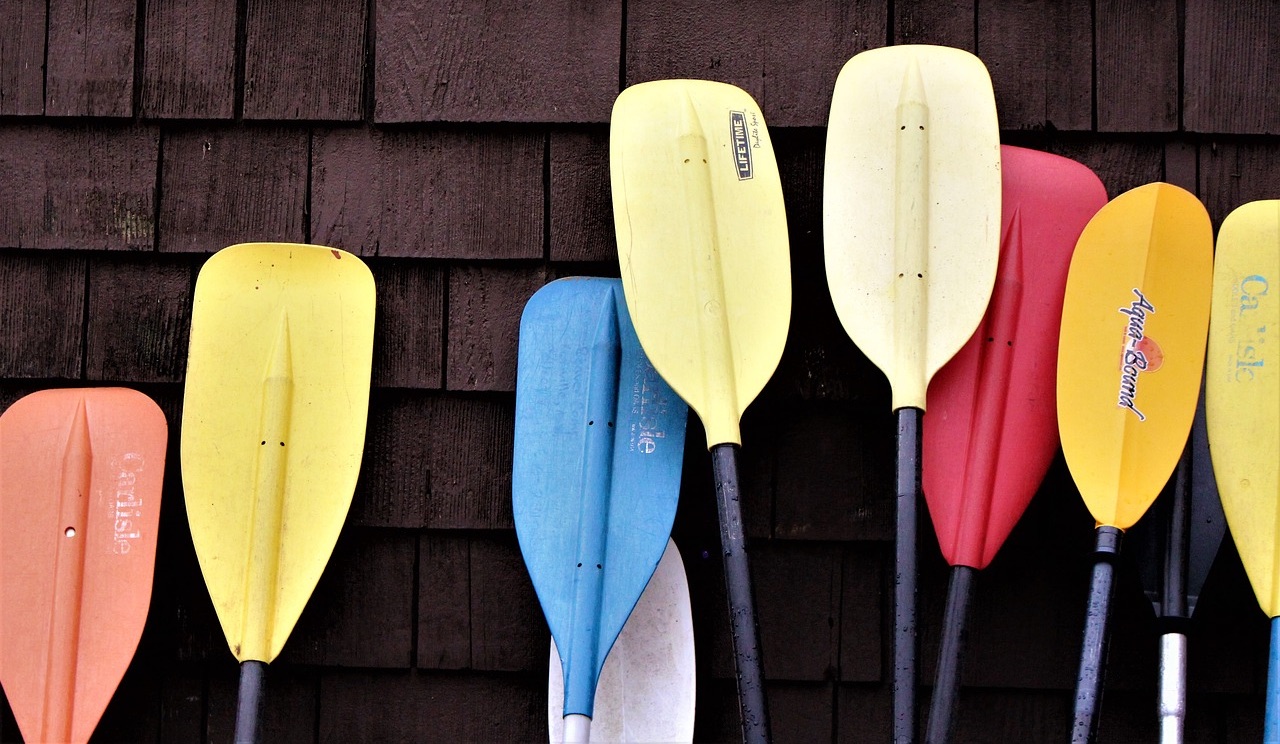
In this overview, we’ve put together a list of kayak paddles that we think are worth your attention in 2023. There’s also a buying guide to help you choose the best kayak paddle for your adventures.
As an affiliate of Amazon and other retailers, we may earn a small commission when you buy via our links, at no additional cost to you. Thank you!
At a Glance: Best Paddles for Kayaking in 2023
- Best Paddle for Beginners: Bending Branches Whisper
- Best Recreational/Touring Paddle: Aqua-Bound Sting Ray Posi-Lok
- Best High-Angle Recreational Paddle: Aqua-Bound Manta Ray Carbon
- Best Kayak Paddle for Fishing: Bending Branches Angler Classic
- Best Kayak Paddle for the Money: Bending Branches Sunrise Glass
- Best Whitewater Kayak Paddle: Werner Sherpa
- Best Kayak Paddle for Kids: Perception Hi Five
Comparison Table: Top Rated Paddles for Kayaking
| Model | Specs | Where to Buy |
 Bending Branches Whisper | Shaft Material: Aluminium Blade Material: Polypropylene Weight: 37 oz. (1049 g) | Amazon |
Aqua-Bound Sting Ray Posi-Lok | Shaft Material: 100% Carbon Blade Material: abXII Fiberglass reinforced nylon Weight: 30.5 oz. (865 g) | Amazon |
Aqua-Bound Manta Ray Carbon | Shaft Material: 100% Carbon Blade Material: abX Carbon reinforced nylon Weight: 29.5 oz. (836 g) | Amazon |
 Bending Branches Angler Classic | Shaft Material: Fiberglass Blade Material: epX Polymer, Fiberglass reinforced Weight: 34 oz. (964 g) | Amazon |
 Bending Branches Sunrise Glass | Shaft Material: Fiberglass Blade Material: Polypropylene Weight: 35 oz. (992 g) | Amazon |
 Werner Sherpa | Shaft Material: Fiberglass Blade Material: Fiberglass Weight: 34.75 oz. (985 g) | Outdoorplay |
Perception Hi Five | Shaft Material: Aluminium Blade Material: Fiberglass reinforced polypropylene Weight: 27 oz. (765 g) | Amazon |
Best Paddle for Beginners: Bending Branches Whisper
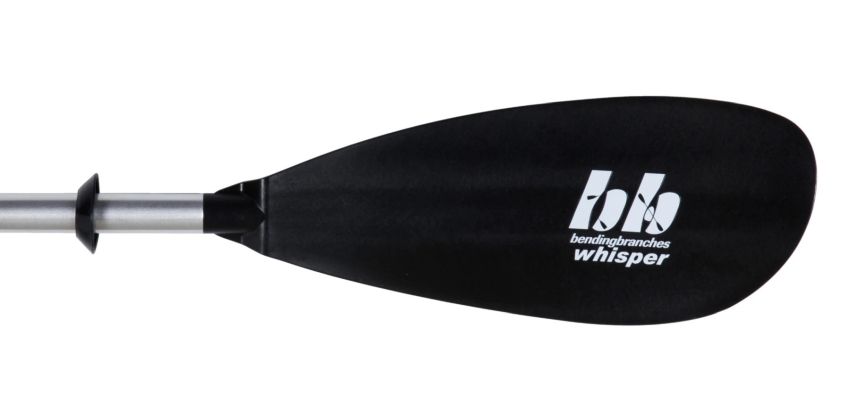
Shaft Material: Aluminium
Shaft Options: Straight shaft. 0° or 60° (Left or Right handed)
Blade Material: Polypropylene
Blade Dimensions: 6.75 x 18 in. (17 x 46 cm)
Blade Size: 89 sq. in. (574 sq. cm)
Lengths: 210 / 220 / 230 / 240 cm
Weight: 37 oz. (1049 g)
USRP: $64.95
Bending Branches Whisper is one of the best selling introductory paddles in North America, and for a good reason.
The Whisper is a solid, two piece paddle. This durable design combines an aluminum shaft with polypropylene blades to create a paddle which can survive an enormous amount of abuse. When you’re starting out paddling, you’re likely to take a few knocks along the way, and it’s reassuring to know you’ve got a paddle which will take those knocks with you.
Don’t be fooled, though. This isn’t just a paddle to beat up and throw away when you’re done with it. It’s a solid, wobble free design which has streamlined asymmetric blades. The design makes the Whisper really easy to paddle with, and the adjustable ferrule lets you choose whether you want flat blades, or to control the paddle with your left, or right, hand.
These are an affordable option for anyone starting out, but bear in mind they come from a manufacturer who makes some of the most popular paddles available. They might be the introductory option for Bending Branches, but they’re a solid and reliable option for a beginner kayaker.
What we like
- Affordable price point
- Easy to use, great beginner option
What we don’t like
- At this price point, nothing
Best Recreational/Touring Paddle: Aqua-Bound Sting Ray Posi-Lok

Shaft Material: 100% Carbon
Shaft Options: Straight shaft, regular diameter (1.18 in.) or small shaft (1.12 in.).
0° / 15° / 30° / 45° / 60° (Left or Right handed)
Blade Material: abXII Fiberglass reinforced nylon
Blade Dimensions: 6.25 x 18 in. (16 x 46 cm)
Blade Size: 91 sq. in. (587 sq. cm)
Lengths: 210 / 220 / 230 / 240 / 250 cm
Weight: 30.5 oz. (865 g)
USRP: $149.95
A lightweight, stiff shaft combined with a pair of incredibly strong blades gives you a paddle which is ideal for adventuring around your local lake, or for longer days out on the water. The adjustable ferrule means you can change your feather on the go, so if conditions start to change throughout the day, you can react to them and make it easier to paddle.
The blades are designed for a relaxed low angle paddle, not only making these ideal for cruising gently around, but in wind you won’t be battling on each and every recovery stroke.
The posi-lok system is incredibly solid and easy to use, giving a reassuring click when the two pieces of the paddle are properly together. This system is corrosion free and eliminates any play that comes from some push button systems.
The Sting-ray is a lot of paddle for the price, the rigid carbon and slight flex in the blades play off one another to give you a comfortable paddle which you know is going to last you for the long haul, and you won’t have to worry about bashing a few rocks along the way.
What we like
- Solid two piece paddle with a strong ferrule system
- Good balance of light, stiff carbon shaft and strong blades
What we don’t like
- Blades aren’t quite as stiff as some similar paddles
Best High-Angle Recreational Paddle: Aqua-Bound Manta Ray Carbon

Shaft Material: 100% Carbon
Shaft Options: Straight shaft, posi-lok two piece. 0° / 15° / 30° / 45° / 60° (Left or Right handed).
Blade Material: abX Carbon reinforced nylon
Blade Dimensions: 7.25 x 18 in. (18 x 46 cm)
Blade Size: 105 sq. in. (677 sq. cm)
Lengths: 210 / 220 / 230 / 240 / 250 cm
Weight: 29.5 oz. (836 g)
USRP: $199.95
Designed for high-angle paddling, the Aqua-Bound Manta Ray Carbon has the largest blade area of all the touring paddles on this list, giving you an incredible bite, pull and release. However, thanks to a carbon shaft, and a lightweight blend of abX carbon reinforced nylon blades, you get all of this power without feeling like you’re swinging around a sledgehammer.
In fact, this paddle feels more like a fully carbon paddle than anything with some nylon in the blades. It is stiff and responsive, while flowing seamlessly through stroke transitions.
The two piece posi-lok keeps the paddle secure, while also allowing you to choose your feather in increments of fifteen degrees. This is perfect for recreational paddlers who are still finding their ideal set up, or for touring paddlers who want to change their approach as they battle through the wind, or drift lazily downstream.
The high angle design really allows you to push your paddling as you move into narrower kayaks, or if you want to play around in surf or near bays, where direct power is necessary to get you moving.
What we like
- Really powerful blade design
- Strong price point for a quality paddle
What we don’t like
- Maybe a little pricey
You may want to check other high- and low-angle Aqua-Bound paddles in our detailed review here.
Best Kayak Paddle for Fishing: Bending Branches Angler Classic
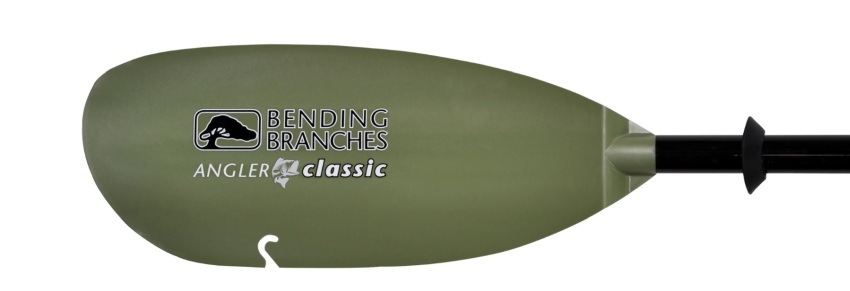
Shaft Material: Fiberglass
Shaft Options: Straight shaft. 0° or 60° (Left or Right handed)
Blade Material: epX Engineered Polymer, Fiberglass Reinforced
Blade Dimensions: 6.9 x 17.5 in. (18 x 44 cm)
Blade Size: 95 sq. in. (613 sq. cm)
Lengths: 220 / 230 / 240 / 250 / 260 / 260 / 270 / 280 cm
Weight: 34 oz. (964 g)
USRP: $139.95
Kayak fishing paddles don’t come much more popular than this! The Angler Classic paddle by Bending Branches is a step up from the company’s entry-level designs. We love this solid paddle, which would be perfect for beginner anglers but can also last you for years.
The Angler Classic paddle is pretty lightweight by the standards of plastic-bladed paddles. The fiberglass shaft makes the paddle stiff and responsive, but also sturdy and comfortable to use over longer distances.
In our tests, the blades proved to be really strong. They are made from fiberglass-reinforced polymer, which saves weight and makes the blades stiff enough for the most powerful strokes.
The Angler Classic comes in the snap button design, which gives you a few choices for feather and a huge selection of lengths. Alternatively, you can buy the “Plus” model, which comes with a fully adjustable ferrule. This ferrule allows you to change the length of the paddle and the feather angle infinitely. Of course, the “Plus” model comes at a higher price.
If you like Bending Branches paddles, but want something a little lighter, there’s always the Angler Pro. The Angler Pro paddle has a similar design but comes with fiberglass blades.
What we like
- Great value
- Strong, smooth design
What we don’t like
- Limited adjustability (unless you get the Plus model)
Best Kayak Paddle for the Money: Bending Branches Sunrise Glass
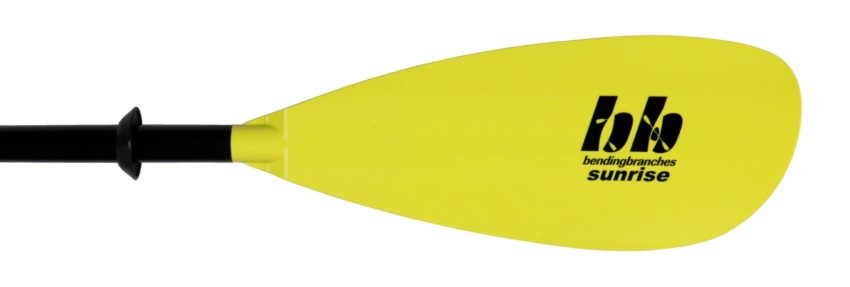
Shaft Material: Fiberglass
Shaft Options: Straight shaft. 0° or 60° (Left or Right handed)
Blade Material: Polypropylene
Blade Dimensions: 6.75 x 18 in. (17 x 46 cm)
Blade Size: 89 sq. in. (574 sq. cm)
Lengths: 210 / 220 / 230 / 240 cm
Weight: 35 oz. (992 g)
USRP: $99.95
The Sunrise Glass is essentially the same paddle as the uber-popular Bending Branches Whisper but with a fiberglass shaft, rather than aluminum. This saves you a couple of ounces in weight, but also makes the whole paddle feel far more responsive and smoother, especially over longer distances.
Beyond that, you still get the solid Bending Branches design which makes them unendingly popular throughout North America.
Polypropylene blades may not be the most technical option, but they will last forever, so you won’t need to worry if you play to push off beaches or bump off rocks as you career down a lazy river.
This is arguably the best of the “under $100” bunch. The blades are a smoother shape than most others on here, and they will feel more like one of the higher level touring paddles than something aimed purely at beginners.
What we like
- Basic paddle with a strong, smooth blade
- Bending Branches are renowned for making solid, quality paddles
What we don’t like
- Polypropylene blades can flutter under power
Best Whitewater Kayak Paddle: Werner Sherpa
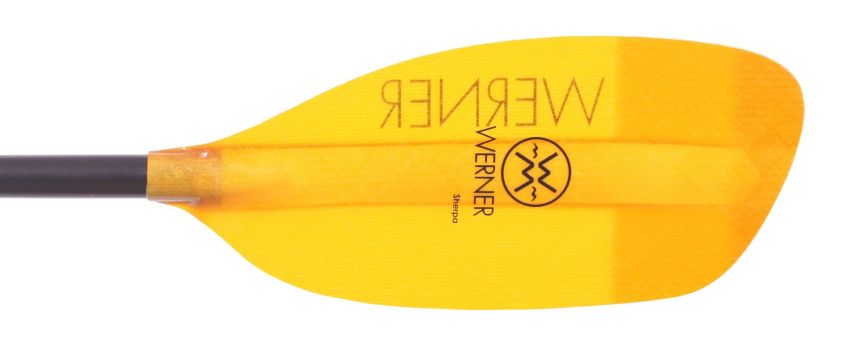
Shaft Material: Fiberglass
Shaft Options: Straight shaft, 30° or 45° right handed. Standard or small shaft options. Bent shaft available at extra cost.
Blade Material: Fiberglass
Blade Dimensions: 7.75 x 18 in. (19.5 x 46 cm)
Blade Size: 105 sq. in. (680 sq. cm)
Lengths: 191 / 194 / 197 / 200 cm
Weight: 34.75 oz. (985 g)
USRP: $260
Smooth like butter. The Sherpa from Werner Paddles has long been one of the most popular white water paddles on the market and there’s a really good reason for that. In an environment where linking strokes seamlessly together is of utmost importance, you need a paddle you can rely on to catch, release and recover in one fluid movement.
The Sherpa is unassuming in this sense, but once you start paddling with it you’ll wonder why anyone uses anything different. The smaller brother of the Powerhouse, which is increasingly popular in tight creeks and off drops, the Sherpa is an all round classic.
Fiberglass shaft and blades keep it stiff, responsive and durable, and you can get hold of this paddle in standard or small shaft options. You can also get a bent shaft for an extra cost, if that’s what you’re into.
What we like
- It wouldn’t be used by so many pro paddlers if it wasn’t as good as it is
- Recovery and linked strokes is second to none
What we don’t like
- Longer blades can slow your cadence. Some environments demand high cadence and powerful strokes. In this case, look to the Player or Sidekick paddles
Best Kayak Paddle for Kids: Perception Hi Five

Shaft Material: Aluminium
Shaft Options: Straight shaft. 0° or 60° (Left or Right handed)
Blade Material: Fiberglass reinforced polypropylene
Blade Dimensions: Not stated
Blade Size: 65 sq. in. (425 sq. cm)
Lengths: 190 cm
Weight: 27 oz. (765 g)
USRP: $39.99
This is the accompanying paddle to Perception’s popular Hi Five kayak/SUP crossover for kids and is perfectly designed for youth users.
The small shaft, with ferrule options of no feather or sixty degrees either direction, gives room for progression as your child develops through the sport. Not only that, but the aluminium build means it will last even if it’s bounced around, dropped or trodden on as they splash around and jump on and off their kayak.
The blades are smaller than others on this list, giving them a smooth and easy going catch and release, making recovery easy too. When kids are starting out, it’s important to make things as straightforward as possible, and by giving them a paddle which is both easy to use and doesn’t tire them out, they’re more likely to stick with the sport for longer.
RELATED: Best Life Jackets for Kids – Reviews and Buyer’s Guide
These are cheap, light and durable. Although the small blades are great for starting out, they might be time-limited. As your child starts to get more confident and wants to go further, or faster, the small blades may feel like they limit them slightly.
What we like
- Really lightweight
- Small blades make it easier to grasp strokes
What we don’t like
- Might be outgrown quickly
How to Choose a Kayak Paddle: Expert Advice
Paddles. All they do is push you through the water, right? Why is it that every time you get on the water with someone new, they have a paddle you’ve never seen before? And why, when you borrow someone else’s paddle which they so fiercely defend as “the best paddle they’ve ever used,” do you hate it?
Simply put, a paddle is an extension of your arms; it’s the step up from sitting in your boat and swimming your way through the water.
Similar to how your boat needs to fit you perfectly for you to get the most out of it, your paddle needs to sit right in your hands or complement your body movement. The paddle chooses the paddler.
This all sounds very spiritualistic and nonsensical. Of course, it’s possible to paddle with someone else’s paddles, much like how you can jump in someone else’s boat. It might even be the case that you realise you prefer their paddles and change your allegiance altogether. But how much difference and science can there really be in a stick with two flaps on the end? And what is it that makes them so different from one another?
What a Paddle Does
To understand the difference in paddles, we first need to know exactly what a paddle does. Paddles are designed to grip the water and stay in place. As you twist your core and push through the stroke with your top hand, a levering motion takes place as the blade pushes against the water; this drives the boat forwards.
Of course, there will be some ‘slippage’ of the paddle blade in the water. This is considered wasted energy as the transfer of power isn’t directly driving the boat, and it’s this ‘slippage’ which paddle manufacturers work so hard to minimise.
The paddle is an extension of your arms; your primary means of transferring power from your body to the water and propelling the kayak. But what is it that makes it so personal? And why are there different paddles for each discipline?
What Paddle Length Do I Need?
Maybe the easiest place to start is how long your paddle needs to be. For recreational kayakers, this is a straightforward decision involving your height and the width of your boat. The chart below gives a rough guide for recreational and touring kayaking. This can also be applied to disciplines such as kayak fishing.
Touring (Low Angle) Paddle Sizing Chart
| Paddler Height | Kayak Width | |||
| up to 23″ | 23″ to 28″ | 28″ to 32″ | over 32″ | |
| Less than 5′ | 210 cm | 220 cm | 230 cm | 240 cm |
| 5′ to 5’6″ | 215 cm | 220 cm | 230 cm | 240 cm |
| 5’6″ to 6′ | 220 cm | 220 cm | 230 cm | 250 cm |
| 6′ and taller | 220 cm | 230 cm | 240 cm | 250 cm |
Low Angle Paddling
Low angle paddling is considered to be when the top hand stays roughly level with your shoulders throughout the stroke. This is a more relaxed approach to kayaking which relies less on technique and allows you to cruise all day as a beginner, without exhausting yourself. The downside is that because of the wider angle, your paddle is liable to arc away from the boat throughout the stroke and you may find yourself spending more time correcting your path. Low angle paddling is often suited to recreational kayakers in calm environments.
High Angle Paddling
High angle paddling relies on good form and effective paddling technique, using the core muscles rather than relying solely on your arms. Here, your top hand is likely to be level with your eye line rather than your shoulders, and your paddle will follow a straighter line down the side of your boat so that all of your efforts go into propulsion, rather than turning the boat. High angle paddling is more suited to experienced paddlers and challenging environments. Without proper paddle technique, this can be exhausting and you will quickly revert to low angle paddling.
RELATED: High Angle vs. Low Angle Paddling: Different Strokes for Different Folks
Cadence/Stroke Rate
When you start to look at paddles for more technical environments, such as whitewater kayaking or sea kayaking in rock gardens or rough conditions, there are other factors which determine your paddle length. One of the major influencers here is cadence or stroke rate.
Longer paddles spend more time in the water and accordingly more time out of the water as you set up for the next stroke. A shorter paddle equates to a shorter paddle stroke and faster recovery, therefore a much faster paddling rate. For cruising and recreational paddlers, this is not beneficial, you expend more energy even if you have perfect paddle form. However, in choppy sea conditions, rock gardens or white water, balancing propulsion and cadence is essential for success.
In choppy sea conditions, rock gardens or white water, balancing propulsion and cadence is essential for success.
Sea kayaking in choppy conditions requires a paddle long enough to propel you effectively, but short enough to accelerate quickly and spend less time without the paddle engaged in the water. Meanwhile, sea kayaking in rocky outcrops and playing around in the surf requires a paddle you can use to accelerate quickly and recover from the water quickly to change your angle and position on the water. This means you’re likely to want a shorter paddle for both of these specific situations, especially playing around in the rocks; you’re looking at dropping about 5 – 10 centimetres on the above chart.
White water kayakers use the shortest paddles of all, looking to maximise stroke rate and put the power down in short, sharp bursts of speed. This is especially prevalent in playboating, where lateral movements and power bursts are timed with body movement and slight changes in the wave and paddles tend to be even shorter for this. River runners are likely to be dropping around 15- 20 centimetres from the above chart, while playboaters would be looking around the 20 – 25 centimetre range.
White water river running kayaking size chart, taken from Werner paddles.
Blade Shapes: Symmetric or Asymmetric Blades?
As well as the overall length of the paddle, the length and shape of the blade play an important part in how a paddle interacts with the water. Most kayak paddles now have asymmetric blades, as opposed to the traditional blades which are symmetrical above and below the shaft. Kayak blades also tend to be curved, with a concave power face gripping the water more effectively than a flat blade.
Top blade, asymmetric. Bottom blade, symmetric. Image is taken from Boat-ed.
Symmetric paddles can allow you to put down a lot of power, but there’s nothing smooth about paddling with them. The asymmetry allows you to plant the blade effectively and maximise the power face of the paddle all the way through your stroke. Different blade shapes, therefore, are suited to high and low angle paddlers as this will impact on how your paddle enters the water and flows through your stroke.
Once you get into the particular disciplines, this asymmetry will allow you to propel the boat differently. Longer blades work similar to longer paddles and can give you a more efficient cruising stroke, while shorter blades increase your potential cadence and manoeuvrability in tight settings.
In even more nuanced situations, paddles generate power in slightly different ways and the shape of the blade will decide whether you have a smoother transition through linked paddle strokes, an ability to quickly plant and generate power and even how that power transitions through your boat in certain situations, such a boof strokes in white water.
Paddle Materials: Plastic, Fiberglass, or Carbon?
The shape of the blade and the length of your paddle contribute to how it puts down power, but this is also affected by what it’s made from.
The three most common materials for kayak paddles are plastic, fiberglass and carbon fiber. Each of these has their individual benefits and drawbacks.
Plastic Paddles
Plastic paddles are very robust and will probably outlast your kayaking career unless you do something drastic, making them perfect for playing around rocks and sharp coastlines. Besides that, plastic paddles are also much cheaper than alternatives, making them perfect for the beginner or recreational paddlers who don’t need the specific advantages of a fiberglass or carbon paddle.
The downside to plastic paddles is their flex, which you will often notice once you get into more progressive strokes or into high powered, high angle paddling. When you’re in a situation where every bit of effort matters, a flexible paddle isn’t particularly desirable. For this reason, experienced paddlers rarely use them.
Fiberglass Paddles
In the middle of the road and probably the most common among sea kayakers and white water kayakers are fiberglass blades. These are much stiffer and lighter than their plastic counterparts and also tend to ‘slice’ through the water more effectively which makes them very capable of performing linked strokes.
Fiberglass is prone to chipping and slowly wearing down over time and it’s not uncommon when comparing a heavily used white water blade against a brand new one to see a completely different blade shape and size.
Carbon Paddles
If power transfer is key and you can’t afford to lose anything to flex, carbon is your friend. By far the lightest, stiffest and most expensive of the three, carbon is often considered to be unnecessary to all but those who need to maximise effort; slalom kayakers or sea kayakers on long multi-day trips.
Carbon is even more susceptible to breaking than fiberglass and often splinters if you bounce it off too many rocks. In particularly rocky creeks you can watch your money falling away in front of your eyes!
Carbon blades also open up the possibility of having a core to the blade, usually either foam or air. This core not only makes the paddle lighter but means that when it comes to rolling in high-pressure environments, your paddle naturally wants to be on the surface of the water making the action easier and quicker.
The Shaft
Holding the two blades together is the shaft. Surely that bit’s easy right? It’s just a tube.
Not quite. The shaft is your direct feedback link to the water. Couple this with the fact that you wrap your hands around it for hours at a time, you want it to be comfortable.
Straight and Cranked Shafts
Most recreational kayak shafts are straight, but you may have seen people on the water with bent shafts, otherwise known as cranked paddles. The idea of these bent shafts is to put your wrists in a more ergonomic position and reduce strain through your wrists, reducing the risk of tendonitis. Bent shaft paddles are especially popular among sea kayakers who are most at risk of repetitive strain injuries from overuse, but have found their way into all disciplines.
The idea of bent shafts is to put your wrists in a more ergonomic position and reduce strain through your wrists, reducing the risk of tendonitis.
The only way to fully decide whether they’re for you is to try them and see for yourself, but it can take a while to get used to a cranked paddle.
Shafts also come in different widths, generally small shaft and regular shaft. Smaller framed paddlers benefit from the lower weight and easier grip they gain from the smaller shaft.
Left-handed and Right-handed Paddles
Some companies also add a slight teardrop shape to the paddle where your hands will be positioned. Sometimes this is done for both hands, sometimes just for your primary hand. If you didn’t know that paddles come in left and right-handed, see the next section; ‘Feather’.
RELATED: 12 Best Kayaking Gloves for 2023
Shaft Materials
Materials differ, too, and you can often choose between fiberglass and carbon shaft. Asides from the obvious price and weight difference, these alter how much flex you will get from the paddle. A full carbon, non cranked paddle, for example, is extremely stiff and this can put you at risk of repetitive strain injuries in certain situations. By changing the shaft for fiberglass you can add just enough flexibility to reduce your likelihood of getting injured.
Feather
Have you ever looked at a kayak paddle and wondered why the blades are off at different angles and thought it would be a lot easier to paddle if they were both the same? You’re not alone. Most beginners wish their paddle wasn’t feathered, but soon the movement becomes fluid and the reasons become apparent.
While one of your blades is engaged in the water, the other is moving through the air, ready to be planted again for the next stroke. Without feather, this top blade would be fully open, as it is in the water, and wind resistance would mean you had to work harder for each recovery; more wasted effort. This may seem menial on short paddles, but over long days and in windy conditions it becomes incredibly important.
Initially, this was overcome by putting the blades at a 90° angle so that the top blade cut through the wind perfectly. This design survived for hundreds of years before recent design showed that this was putting kayakers at much greater risk of injury. Modern paddles vary between 15° and 45°.
Some of this decision comes down to preference, but it’s often situational. White water and sheltered environments are less wind affected and a lower degree of feather is often adequate. Sea kayaking and open water touring often use a higher degree of feather as they have to recover their paddle strokes through rough winds and choppy conditions.
As we said before, paddles are either left-handed or right-handed. This primary hand is the one which performs the ‘twist’ to position the blade, ready for the stroke, while the other acts as a guide. It’s important to know whether you’re left-handed or right-handed as it’s important to get your feather round the right way.
Paddles are available with variable feather, so you can alter your paddle as conditions change. This can also allow you to change between left and right-handed paddling.
Some white water kayakers, especially playboaters, have made the transition to 0° feather, or flat paddles. This means that no time or effort is wasted twisting the paddle and you can maximise paddle cadence and, in terms of playboating, direct power through some moves.
One-Piece vs Split Paddles
As well as one-piece paddles, you can get split paddles. These come in two, three or four pieces, depending on your needs. These paddles are much easier to fit in your car, but there’s a bit more to it than that.
Split sea kayaking paddles usually have adjustable feather as we previously mentioned, but they also have adjustable length, too. Two-piece splits are often carried on the top deck of a sea kayak as a quick-to-deploy spare paddle.
Split paddles for white water are becoming more adjustable and usually at least have the option of left or right-handed. These are usually only carried as an emergency spare, rather than a primary paddle. Even with modern split paddle design, it goes without saying that the more connections you put into a paddle, the more potential it has to break, but these are an essential piece of kit on more challenging rivers and multi-day trips.
This is a lot of information, how do I pick my paddle?
That’s a hard decision, unfortunately. All of these elements and nuances need to be taken into consideration when you’re picking your first or your fiftieth paddle, but there’s still that element we can’t account for; personal choice. Nothing quite beats trying a paddle out on the water, but this isn’t always an option.
Now that you have read this guide and have an understanding of the different elements that make up a paddle, as well as the technology and design which go into them, you can look at a range of paddles more objectively and make a better decision about what might suit you and your paddling style.

